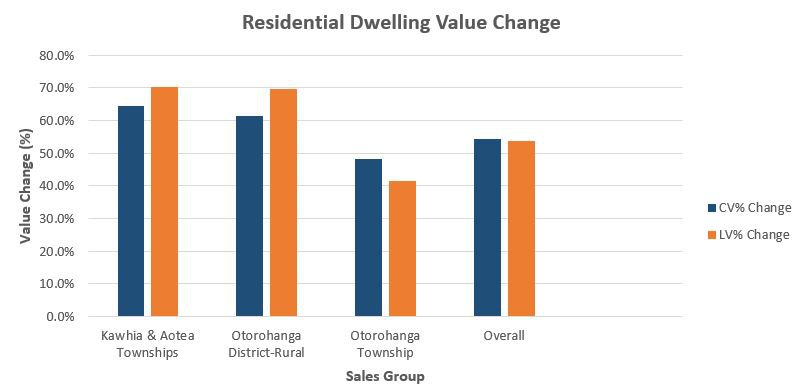New rating valuations for Otorohanga District

Ōtorohanga District property owners will soon receive a Notice of Rating Valuation in the post with an updated rating value for their property.
The new rating valuations have been prepared for 5287 properties on behalf of the Ōtorohanga District Council by independent valuers Quotable Value (QV). Their careful analysis shows the total rateable value for the District is now $6.6 billion a 30.3% increase, with the land value of those properties now valued at $4.4 billion, a 24.7% increase.
On average, the value of residential housing has increased by 54% since 2019 with the average house value now sitting at $566 000, while the corresponding average land value has increased by 54% for an average of $286 000.
QV senior consultant Stuart Smith commented: “It will likely come as no surprise that residential property values are now much higher than they were in 2019, when our last rating revaluation for Ōtorohanga was performed. During this period, we witnessed property values grow a great deal both locally and nationally in 2020 and especially 2021, primarily as a result of record low interest rates. They have fallen back somewhat in 2022, but still remain a long way off their pre-pandemic levels overall.”
He said the rural sector had observed somewhat more subdued growth overall, with pastoral properties showing a 33.6% increase since the district’s last rating revaluation in 2019, with dairy experiencing just a modest 3.4% average increase. The largest increase in the rural sector was for land suitable for forestry, which increased 50.5%.
Meanwhile, commercial property values in Ōtorohanga have increased by 44% on average, and property values in the industrial sector have increased by 64% since the district’s last rating valuation. Commercial and industrial land values have also increased by 49% and 96% respectively.
Since 2019, the average capital value of an improved lifestyle property has increased by 48% to $868,000, while the corresponding land value for a lifestyle property increased by 43% to $501,000. “Rural values in Ōtorohanga are underpinned by a strong lifestyle market,” Mr Smith added.
Ōtorohanga District Mayor Max Baxter added: “Just because the total value of the district has increased, doesn’t mean the council will get more in rates. Council has to set a budget first and then we apply our rating formulas to work out who pays what. It’s a complex process that will be undertaken in the next few weeks as the new council elected in October prepares their first Annual Plan.”
Residential housing value changes since 2019 revaluation levels

What are rating valuations?
Rating valuations are usually carried out on all New Zealand properties every three years to help local councils set rates for the following three-year period. They reflect the likely selling price of a property at the effective revaluation date, which was 1 October 2022, and do not include chattels.
It is helpful to remember that any changes in the market since that time will not be included in the new rating valuations. Often this means that a sale price achieved in the market today will be different to the new rating valuation set at 1 October 2022.
The updated rating valuations are independently audited by the Office of the Valuer General and need to meet rigorous quality standards before the new rating valuations are certified. They are not intended to be used as market valuations for raising finance with banks or as insurance valuations.
New rating values will soon be posted by QV to property owners. If owners do not agree with their rating valuation, they have a right to object through the QV objection process before 27 April 2023.
Find out more about the rating revaluation and objection process.




